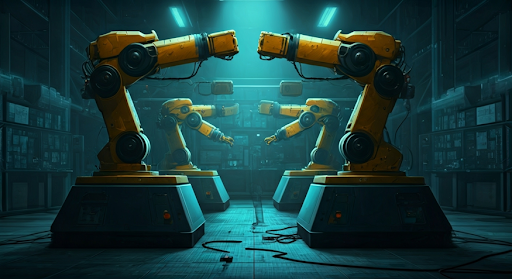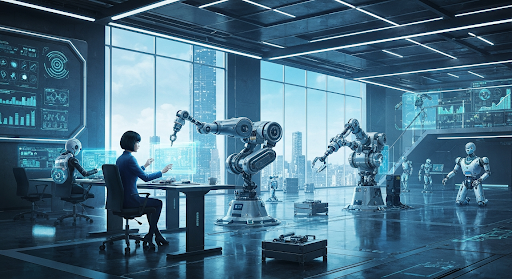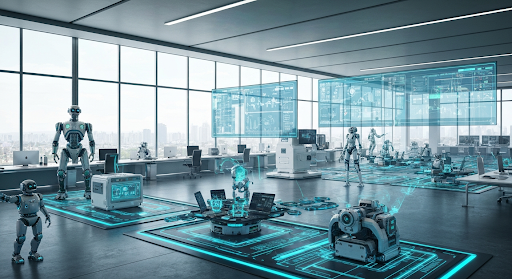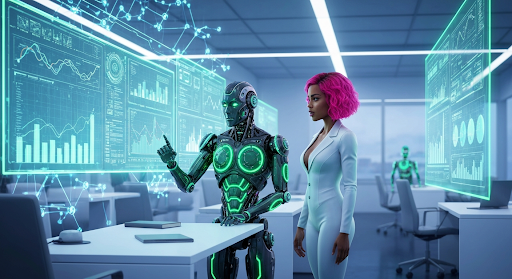How Robots Automation Transforms Business Operations
Key Highlights
- Robot automation and artificial intelligence are fundamentally transforming how companies run daily operations and streamline business processes.
- Robotic process automation (RPA) uses software bots to eliminate repetitive digital tasks, boosting productivity and accuracy.
- Industrial robots and collaborative robots reshape manufacturing, logistics, and service industries by automating complex physical processes.
- Automation technology, including intelligent process automation and machine learning, reduces human error and enhances overall business process automation.
- Businesses adopting advanced automation systems gain a notable competitive edge, benefiting from improved efficiency, consistency, and scalability.
Introduction
Automation technology is driving a wave of digital transformation across every industry. Today, business process automation isn’t just a trend—it's a necessity for staying competitive and innovative. Companies implement digital systems and automated workflows to remove bottlenecks, cut operational costs, and enable employees to focus on more strategic activities. By integrating automation technology, organizations can revolutionize their operations, optimize routine work, and set the stage for smarter decision-making. This evolution in automation is key to future-proofing business models and achieving real growth.
Understanding Robotics and Automation in Business

Robotics and process automation have become the backbone of modern business innovation. Robotics involves the use of programmable machines and sophisticated automation systems to handle tasks that previously demanded human intervention. In contrast, process automation spans a wide spectrum from simple software-driven actions to intricate industrial systems.
As these technologies evolve, organizations are equipped to automate a diverse range of activities—from digital paperwork to physical assembly lines. By embracing robotics and automation systems, businesses unlock new levels of precision, reliability, and flexibility, setting themselves apart in a rapidly changing marketplace.
Defining Automation: Concepts and Scope
Automation is the use of technology—ranging from computer software to advanced machines—to perform tasks without constant human input. At its heart, process automation allows companies to complete repetitive or rule-based tasks more efficiently, freeing up human workers for strategic duties. Automation systems can be broadly categorized into two types: software automation, which streamlines digital processes such as data entry or financial services, and industrial automation, which controls physical machines and production lines.
One key distinction to understand: robotics and automation are related but not identical. Automation includes a wide set of technologies, while robotics focuses specifically on programmable machines interacting with the physical world. As Evan Beard of Standard Bots puts it, “Robotics is a branch within the broader field of automation, focusing specifically on physical robots.” In industry, automation systems might handle digital document processing or operate a fully automated production line, each leveraging unique technologies to enhance efficiency.
Robotics Explained: Types and Roles in Industry
Robotics centers around designing, building, and programming machines—robots—that can execute tasks autonomously or with limited human guidance. Industrial robots are a common sight in manufacturing and logistics, while collaborative robots (cobots) are engineered to work safely alongside humans. Physical robots can be reprogrammed for various roles, adding flexibility to fast-changing work environments.
In warehouses and logistics, the following types of robots are frequently used:
- Automated Guided Vehicles (AGVs) for material movement
- Robotic arms for picking, packing, and sorting
- Autonomous mobile robots (AMRs) with computer vision for navigation
- Collaborative robots for tasks like palletizing or order fulfillment
These programmable machines enhance accuracy, reduce workplace injuries, and accelerate processes. With advances in computer vision and artificial intelligence, robots now perform tasks that demand both precision and adaptability, making them indispensable across industries.
Key Differences and Overlaps Between Robotics and Automation
While robotics and automation are often mentioned together, they serve distinct yet overlapping roles in business operations. Robotics focuses solely on creating physical robots that interact with the real (physical) world, while automation encompasses both software-driven and physical processes. For example, automation can mean using software robots for virtual business tasks or deploying industrial robots for assembly lines.
Despite their differences, both approaches can work together, blending human intelligence with automation software to optimize workflows and achieve higher performance in diverse business settings.
Distinct Features and Industry Applications
Automation technology and advanced technologies like process mining, intelligent automation, and robotics are used across a broad spectrum of industry applications. Automation excels in repetitive, rule-based tasks, while robots are best for tasks needing flexibility and interaction with physical objects. The use of robots has expanded far beyond manufacturing, now touching logistics, healthcare, and customer service.
Compare their application with this table:
| Technology | Key Features | Typical Applications |
|---|---|---|
| Automation | Software or machines, rule-based | Data entry, process mining |
| Robotics | Programmable machines, sensors | Welding, palletizing, QA |
| Combined | Physical+software, AI-enabled | Smart factories, warehouses |
Over time, robots have evolved from simple pick-and-place machines to highly intelligent systems. Today's technology integrates artificial intelligence and real-time data analytics, enabling companies to achieve higher productivity, "making automation and robotics a catalyst for new sectors," as noted by industry leaders.
Scenarios Where Robotics and Automation Converge
There are many situations where intelligent automation and robotics intersect to deliver powerful results. Intelligent automation combines cognitive automation, software robots, and physical robots to handle complex business processes and production lines. This convergence drives greater flexibility and capability in operations.
Key scenarios include:
- Collaborative robots (cobots) working safely with humans on production lines
- Intelligent bots using data analytics to optimize machinery in real time
- Software robots automating quality control in physical environments
- Integrated systems managing both digital workflows and physical logistics
Collaborative robots differ from traditional industrial robots by being more adaptable and safer to operate around people. Cobots are designed for close interaction, require less human intervention for setup, and can be quickly reprogrammed for multiple tasks, making them ideal for dynamic business environments.
Robotic Process Automation (RPA) and Its Role in Modern Businesses

Robotic process automation (RPA) revolutionizes modern businesses by streamlining repetitive tasks and minimizing human error. Utilizing RPA tools and automation software, organizations can enhance operational efficiency through software robots that handle complex workflows. This digital transformation not only reduces the manual workload but also provides a competitive edge in a rapidly evolving market. As businesses adopt intelligent automation solutions, they can focus on higher-value projects, allowing human workers to engage in more strategic initiatives that require human intelligence and creativity.
How RPA Works: Processes and Technologies
RPA implementations center on using software robots to automate rule-based digital business processes. These bots log into applications, complete data entry, generate reports, and transfer files just as human workers would, but with greater speed and accuracy. RPA can be enhanced with intelligent process automation, integrating AI to handle more complex scenarios and adapt to exceptions.
An RPA deployment typically involves:
• Mapping out the process to be automated
• Configuring and training RPA bots to mimic human actions
• Monitoring performance and continuously optimizing the workflow
In business environments, RPA cuts costs, improves compliance, and reduces turnaround time. By delegating repetitive digital tasks to automation software, organizations gain accuracy, trackability, and scalability in their operations.
Popular RPA Software Platforms for U.S. Companies
U.S. companies rely on a variety of RPA software solutions to automate processes efficiently. Leading automation software platforms offer robust rpa tools, user-friendly interfaces, and scalability for diverse business needs. The top choices are known for strong integration capabilities and advanced features.
Popular RPA platforms include:
- UiPath: Highly regarded for its ease of use and strong automation ecosystem
- Automation Anywhere: Favored for scalable automation and cloud-based deployments
- Blue Prism: Recognized for advanced analytics and robust security features
- Microsoft Power Automate: A flexible solution that integrates seamlessly with the Microsoft ecosystem
These platforms help businesses deploy RPA bots across finance, operations, and customer service departments, accelerating digital transformation and delivering measurable results.
Impact of Robots and Automation on Workforce and Operations
The rise of robots and automation has sparked significant workforce transformation. As repetitive tasks shift from the human worker to machines, employees can take on more complex and creative roles. Automation reduces human error, increases operational precision, and reshapes business processes.
Companies now need to reconsider training, upskilling, and change management as part of their strategy. While robots and RPA bots enhance productivity, the transition also brings new challenges for workforce planning and organizational structure.
Enhancing Productivity and Efficiency
Robots and automation drive dramatic gains in productivity and efficiency across industries. In a modern production environment, automation technology streamlines workflows, reduces manual labor, and minimizes downtime. Businesses using process automation gain a competitive edge by operating around the clock without human fatigue.
Key business benefits include:
- Faster, more consistent output in manufacturing and logistics
- Shorter cycle times and improved order accuracy
- Error-free execution of repetitive business processes
Real-world examples are abundant. In logistics, robotic arms and automated guided vehicles speed up picking and packing, cutting fulfillment times dramatically. In finance, RPA bots automate invoice processing, reducing turnaround from days to minutes. These improvements allow businesses to scale quickly and deliver better customer experiences, proving the benefits of RPA and automation aren’t just theoretical—they’re transformative.
Workforce Transformation, Job Roles, and Challenges
The adoption of robots and automation reshapes job roles and prompts a major workforce transformation. As automation technology takes over routine tasks, there’s a growing need for human intervention in managing complex tasks, programming, and problem-solving.
Key changes and challenges include:
- Shift from manual work to roles in software development, robot maintenance, and process optimization
- Increased demand for digital and analytical skills
- The need for ongoing training to adapt to new technologies
- Resistance to change and concerns about job displacement
While automation reduces repetitive tasks, it also brings new opportunities for career growth. However, businesses must address challenges like workforce reskilling and integrating human and automated systems. As “automation supports and enhances human work, rather than replacing it entirely,” companies must prioritize employee engagement while embracing technology.
Conclusion
In summary, robots and automation are revolutionizing business operations by enhancing efficiency, productivity, and accuracy. They streamline processes and free up human resources to focus on more strategic tasks, ultimately transforming the workforce landscape. As companies adopt these technologies, they will not only improve their operational capabilities but also navigate challenges related to workforce adaptation and job roles. Embracing this change is crucial for staying competitive in a rapidly evolving market. If you’re ready to explore how automation can benefit your organization, get in touch for a consultation to discuss tailored solutions that fit your business needs.
Frequently Asked Questions
What are some real-world examples of robots and automation improving business efficiency?
Robots automate repetitive tasks in manufacturing, such as welding and assembly, while RPA bots streamline invoice processing and data management in offices. In logistics, automated guided vehicles and robotic arms accelerate order fulfillment, demonstrating how automation and industrial robots improve business efficiency across industries.
How do collaborative robots (cobots) differ from traditional industrial robots?
Collaborative robots (cobots) are designed to work alongside humans, enhancing safety and efficiency. Unlike traditional industrial robots, which operate autonomously in isolated environments, cobots can share workspace with people, adapting to their movements and tasks without the need for safety cages.
What challenges do businesses face when adopting robots and automation?
Businesses often encounter challenges like integrating automation systems with legacy processes, managing the costs of rpa implementations, and addressing workforce concerns. Software automation can also require specialized skills and careful planning to ensure a smooth transition while maintaining business process continuity and compliance.



